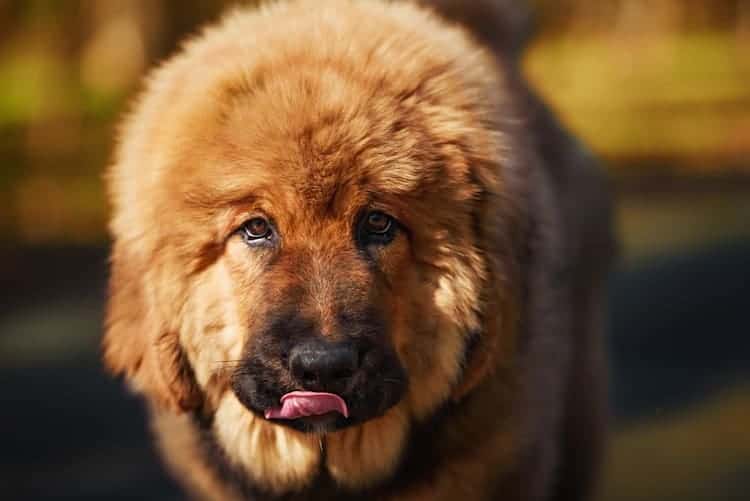If you’re considering a Tibetan Mastiff mix breed, welcome to the designer age! The Tibetan Mastiff is a somewhat rare dog that nonetheless makes for a significant number of interesting crosses.
Read on to learn about the variables to consider for 15 unusual Tibetan Mastiff mix breeds and what the Tibetan Mastiff has to offer as a candidate for crossbreeding.
But first, let’s be sure we’re using the proper terminology.
What’s the Difference Between a Mixed Breed and a Hybrid?
Mixed breeds are often mistakenly called hybrids. A hybrid is an animal that was created by mixing two different species. Examples are the “cabbit” (cat and rabbit) or the mule (horse and donkey).
When we’re talking about dogs, the two parents are of the same species (canine) but different breeds.
Are Tibetan Mastiff Mix Breeds Really “Breeds”?
The dog world is wonderfully varied, and there is a breed for everyone no matter how unusual your taste or lifestyle. But in the past 40 years or so, the rise of the “designer dog” has created still more diversity.
Two that you’re probably familiar with are the Cockapoo (Cocker Spaniel and Poodle, possibly the first “designer dog”) and the Goldendoodle (Golden Retriever and Poodle).
But are these mixes really breeds? It turns out it takes more than crossing two existing breeds to create a new one. It takes several generations over a period of decades before a new breed is considered uniform enough in looks and temperament to conform to a standard.
So, the crossbreeds in this article technically aren’t breeds yet. But for this article, we will continue to call them mixed breeds.
But before we move on, a word of caution. It’s never safe to expect all dogs of a breed to have the same temperament. There will always be individual differences within a breed, even more so when you’re crossing two or more.
If possible, it’s always a good idea to meet and evaluate the temperament of an individual dog before purchasing or adopting any dog.
Please see our Guide to a Successful Dog Relationship for tips on how to evaluate a dog’s temperament and choose the best dog for your lifestyle.
Now let’s explore the world of Tibetan Mastiff (TM) mix breeds!
1. Tibetan Mastiff Siberian Husky Mix
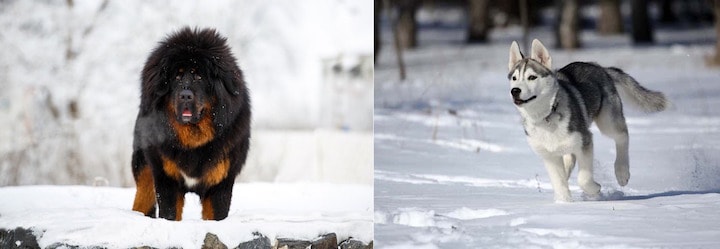
Similarities: Like the TM, the Siberian Husky is generally loyal and gentle. Both dogs are intelligent and can be independent and stubborn.
Both breeds are also untrustworthy off-leash. And they both need early socialization and firm training, so count on having your hands full.
Likely variables: Friendliness. The Husky is accepting of strangers and other dogs, while the TM is a serious watchdog who’s suspicious of intruders.
Possibilities: A mix of the two is almost guaranteed to be a challenge because of their independence and stubbornness. All in all, expect this mix to be double trouble! (Oh, and you’ll need a good fence!)
2. Tibetan Mastiff Corgi Mix
Ok, so one’s a big dog in a small package, and the other’s just a really big dog! We’re not sure how this one came about, but imagine those huge TM lion-like features on the short legs of a Pembroke Welsh Corgi!
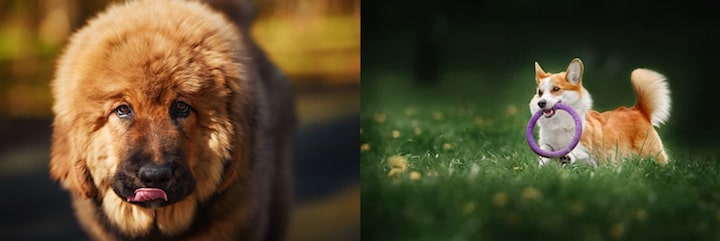
Similarities: Both breeds are intelligent and alert; prepare to have a barker on your hands. They are both friendly with their families, though the Corgi is less suspicious of strangers. Both breeds are working dogs with a moderate need for exercise.
Likely variables: Playfulness and level of interaction. Besides the obvious difference in size, the Corgi can be bold and playful, while the TM finds it hard to let his hair down.
Possibilities: This mix could result in a down-sized Tibetan Mastiff that doesn’t take itself quite so seriously (and loves to herd the children!)
3. Tibetan Mastiff German Shepherd Mix
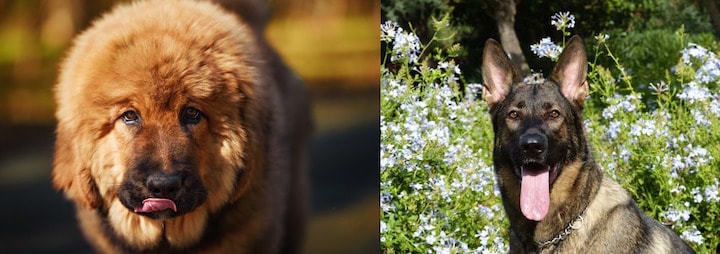
Similarities: These are both loving and family-friendly breeds. But they also have very high guarding instinct and can be aggressive with strangers.
Likely variables: Trainability and health concerns. The GSD is eager to please and obedient, while the TM tends to be more independent. Another gamble: The GSD is prone to many health issues.
Possibilities: If you're looking for a family or property protector, this may be a great mix for you.
4. Tibetan Mastiff Rottweiler Mix
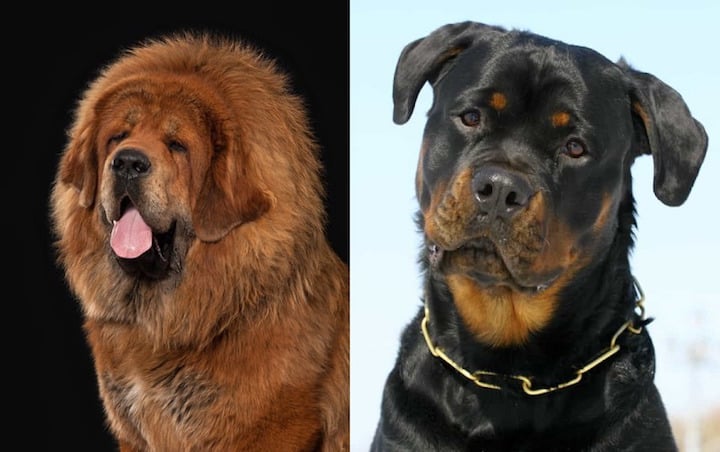
Similarities: Family-friendliness, protectiveness, heavy shedders. Both the Rottweiler and the TM are good with family members. They are both prone to obesity and can be barkers. And be forewarned: These breeds are both heavy shedders.
Likely variables: Obedience and energy level. The Rottie is less independent and more trainable than the TM. The Rottie also has a higher energy level and does best with a job to do or a canine sport.
Possibilities: This mix could create a more obedient Tibetan Mastiff or a lower-energy Rottweiler. Either way, you’ll need a good vacuum.
5. Tibetan Mastiff Caucasian Shepherd Mix

Similarities: Intelligence, family-friendliness, loyal, affectionate, protectiveness, and size. The Caucasian Shepherd (CS) is another giant breed that can grow even larger than the TM—as much as 220 pounds!
These are two enormous dogs with aggressive tendencies. Neither is considered an appropriate choice for an inexperienced dog owner. Both require early socialization and firm training.
Likely variables: Aggression level. The gamble here is likely to be mostly the degree of aggression in the puppies. The TM is easier to train to tame the aggression, but the CS is more challenging. He is less friendly to other pets and strangers and can be fierce when he feels threatened.
Possibilities: This crossbreed would probably make an ideal guard dog.
We don’t recommend this Tibetan Mastiff mix breed for families with children.
6. Tibetan Mastiff Great Dane Mix

Similarities: This is another cross of two giant breeds. The Great Dane (GD) weighs up to 200 pounds with a height of up to 34 inches. Both breeds are gentle and friendly with family and can be sweet and devoted.
Likely variables: Separation anxiety and aggression level. The GD is known as a gentle and reserved giant who can be prone to separation anxiety. Some lines can be more aggressive, however. If you pair an aggressive GD with the super-protective TM, the puppies are likely to need extra-firm and early training.
Possibilities: This mix could make a nice family dog. However, depending on how strong the Great Dane’s anxiety trait is, it may be best suited for families where someone is home during the day.
7. Tibetan Mastiff Mix Saint Bernard Mix
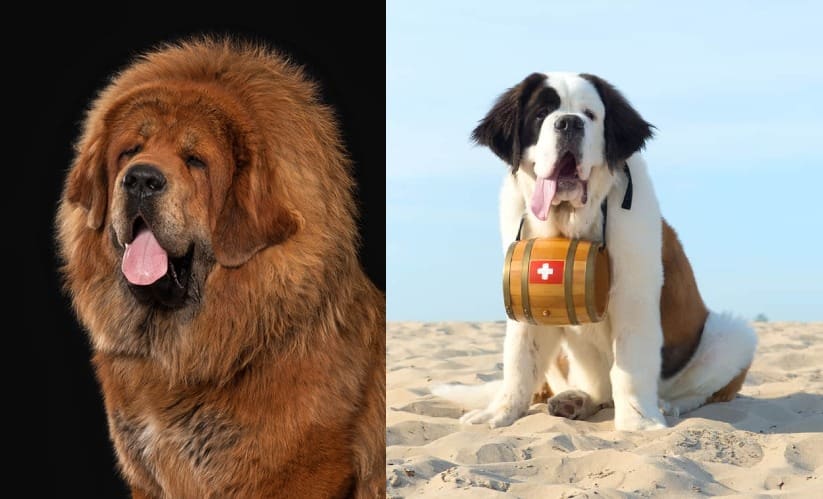
Similarities: Disposition, family-friendliness, affection, shedding. Both the Saint Bernard and the TM are gentle, attentive, and loving to family. They are both thick-coated breeds that have a high tolerance for cold. Both are heavy shedders, though the TM’s coat is easier to maintain.
Likely variables: Stranger reaction and drooling. The Saint Bernard is as friendly to strangers as he is to family. The TM, not so much. With the Saint Bernard, though, there’s a price to pay for all that sweetness: he’s a heavy drooler.
Possibilities: The Saint Bernard in this mix could soften the Tibetan Mastiff’s stranger wariness, or the match could result in a less friendly Saint Bernard. Either way, this cross would probably make a nice family dog.
8. Tibetan Mastiff Lab Mix
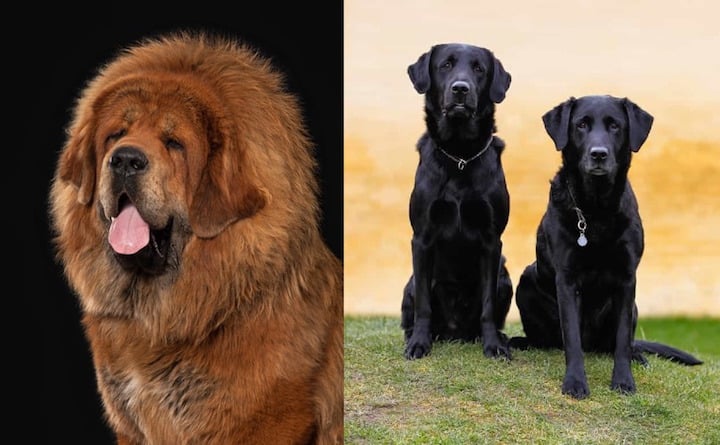
Similarities: Gentleness, intelligence, family-friendliness, obesity, barking. Both the Labrador Retriever and the TM are gentle, intelligent, and family-friendly breeds. However, both are also prone to obesity.
Likely variables: These two breeds have more differences than similarities. The Lab adds energy level, exercise needs, stranger friendliness, and prey drive to the mix. He also has a high energy level and needs an active job to do, preferably hunting. Sadly, the Lab also has a relatively large number of health issues.
Possibilities: With all the variables at play in this cross, it’s hard to predict how the puppies would turn out. Chances are good, though, that they would be good family dogs.
9. Tibetan Mastiff Golden Retriever Mix
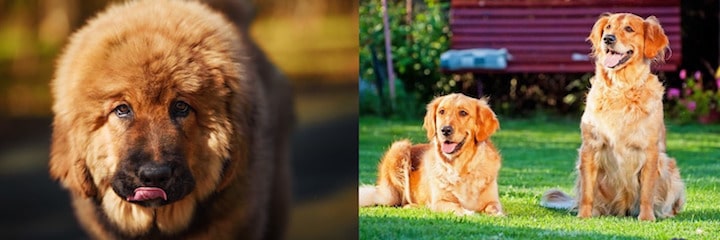
Similarities: Disposition, intelligence, family-friendliness. The Golden Retriever and the TM are gentle, intelligent, family-friendly dogs. Both are heavy shedders.
Likely variables: Energy level, need for mental stimulation, obedience levels, separation anxiety tendency, stranger wariness, health concerns.
The Golden is a moderately high-energy, athletic dog who needs to be busy. He also needs to be with his people and is prone to separation anxiety.
The Golden is easier to train than the TM and is eager to please. He is generally friendly to everyone. Unfortunately, Goldens have more health concerns, including a 60% cancer rate.
Possibilities: Mixing the Golden Retriever’s joyful disposition with any breed is bound to have a positive result. This mix could produce a more energetic TM. It may also soften the Tibetan Mastiff’s stranger wariness. However, it could also work the other way and result in a less exuberant, more stranger-wary Golden. Either way, this mix would probably make a great dog for an active family.
10. Tibetan Mastiff Great Pyrenees Mix
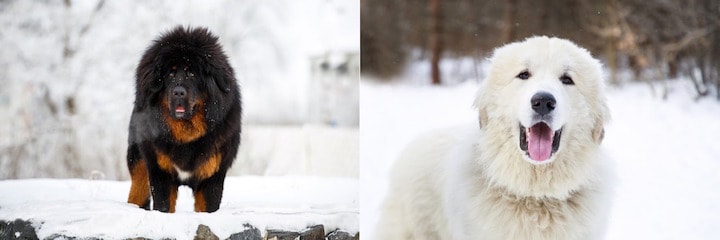
Similarities: Size, independence levels, grooming, barking, intense protectiveness. Though the Great Pyrenees (GP) is smaller than the TM by about 10 pounds and 6 inches, he is also considered a giant breed. The two breeds are known for being challenging to train and are not recommended for inexperienced dog owners.
Likely variables: Level of aggression, overall friendliness. The GP is less likely to be aggressive than the TM, but his guarding instinct may be even more intense than the TMs.
Possibilities: This mix would probably create a good guard dog for a home without children. The intense protectiveness of the Great Pyrenees might cause this cross to guard “his” children too protectively.
11. Tibetan Mastiff Alaskan Malamute Mix
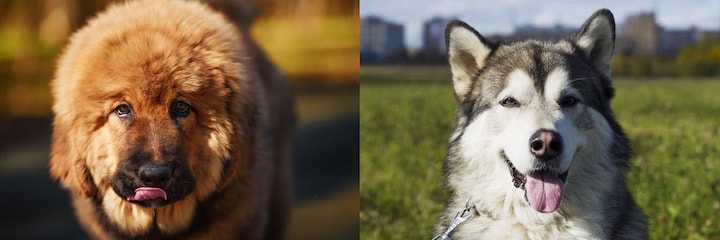
Similarities: Family-friendliness, loyalty, intelligence, independence levels. The Alaskan Malamute and TM are both loyal, friendly, and gentle with kids. They are both intelligent working dogs that can be stubborn and challenging to train.
Likely variables: Exercise needs, playfulness, aggression levels (including food aggression), prey drive, howling. The AM could add a host of challenging behaviors to the pot. They are known to need very firm training and discipline from the beginning.
Possibilities: A mix of these two dogs will almost certainly be a handful because of their stubborn natures. This is also a cross that you would not want to bring into a home with other pets.
12. Tibetan Mastiff Chow Chow Mix
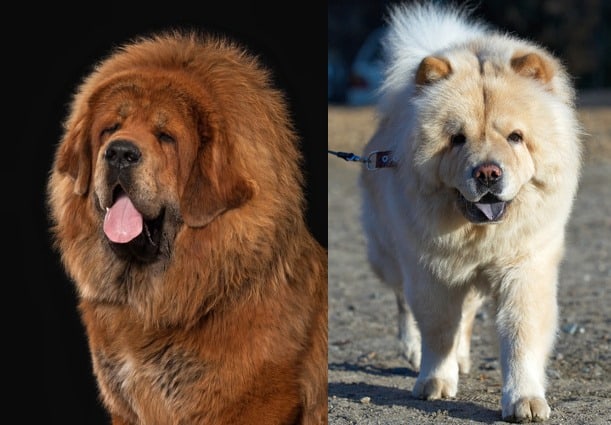
Similarities: Aggressive tendencies, strong will, independence. The Chow Chow is even more likely to be aggressive than the TM.
Likely variables: Devotion, trainability, dominance. The Chow can be intensely loyal, but he is a one-person dog. He is exceptionally strong-willed and is not known for obedience. He believes he should be the boss and needs strict training.
Possibilities: This mix would very likely result in a dog with a high level of aggression that is difficult to tame. With the Chow’s intense devotion to one person, this cross could be dangerously overprotective.
We do not recommend this Tibetan Mastiff mix breed for families with young children. Both have aggressive tendencies, and the Chow Chow is known to bite when provoked or annoyed.
13. Tibetan Mastiff Akita Mix
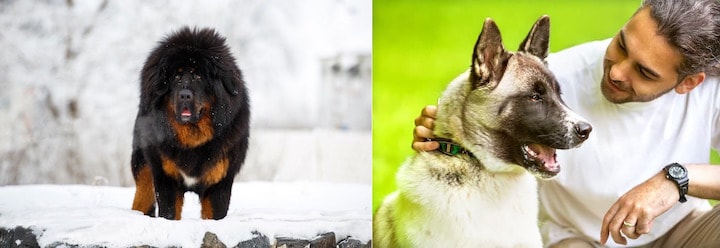
Similarities: Family-friendliness, super-protective. Both breeds need very firm training and socialization.
Likely variables: Devotion, dominance, aggression. When crossed with a TM, the Akita ups the ante when it comes to devotion and loyalty.
However, he is also a naturally dominant dog who doesn’t get along well with most dogs and other pets. He also tends toward aggression with strangers.
Possibilities: This is another mix that would likely be dangerously overprotective. It would probably be best suited to a single-pet home.
We don’t recommend this Tibetan Mastiff mix breed for families with small children.
14. Tibetan Mastiff Bernese Mountain Dog Mix
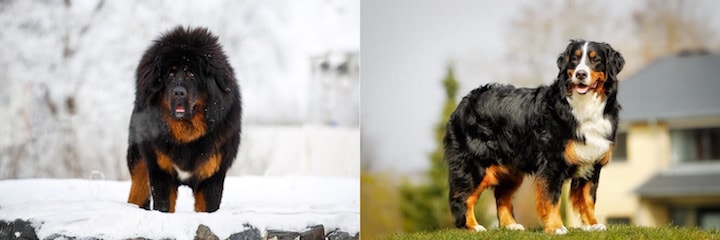
Similarities: Aggression, size, family-friendliness, stubbornness. The Bernese Mountain Dog (BMD) is nearly as large as the TM at up to 120 pounds and 28 inches.
Likely variables: Disposition, dominance, separation anxiety, exercise need, drooling. The BMD brings a sweet, soft disposition to this pairing. He has a high energy level, though, and is prone to separation anxiety.
He also has dominance tendencies and needs proper early training and socialization.
Possibilities: This mix would be like crossing a bear with a lion, and it may be just as frightening because of size alone. While the cross could create a loving family dog, it would probably be challenging to train with a stubborn nature and possible dominance issues.
15. Tibetan Mastiff Newfoundland Mix

Similarities: The most obvious thing these two breeds have in common is their size. The Newfoundland can grow to be 150 pounds and 28 inches. Not the most massive combination on this list, but close! The Newf has slightly less energy, but both breeds need moderate exercise.
Likely variables: Soft disposition, obedience, stranger friendliness.
Possibilities: The Newf brings mostly positive traits to the table when crossed with the TM, so this mix could turn out to be one that softens the TM’s edginess a bit.
Nature isn’t always that accommodating, though, so the Tibetan Mastiff genes could create a more stranger-wary Newfoundland.
Tibetan Mastiff Traits and Temperament
By now, you may be wondering, what's so special about the Tibetan Mastiff? What does this breed bring to the table in the game of designer dog breeding?
The most distinguishing feature of the Tibetan Mastiff is his size. This is a HUGE dog, one of the world’s giant canines.
A male can grow to a weight of 160 pounds and a height of 30 inches tall. When he stands on his hind legs, he is often as tall as a human.
Females can be as large as 120 pounds and 28 inches.
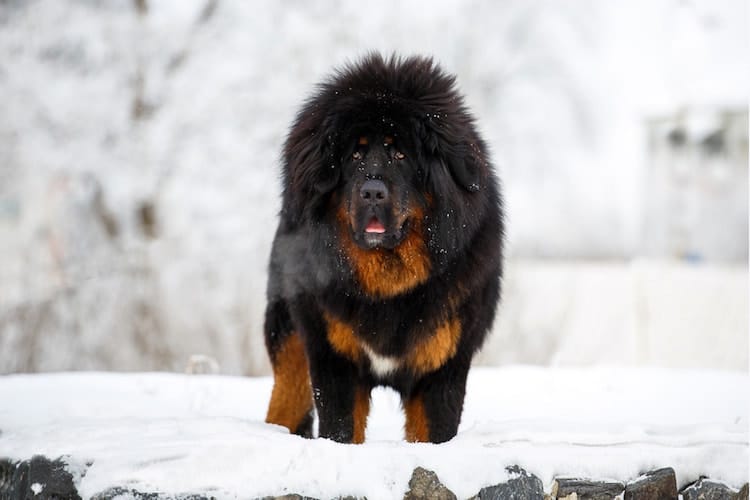
Suffice it to say that the Tibetan Mastiff is going to supersize most breeds it’s crossed with.
Despite his size, though, the Tibetan Mastiff tends to have a gentle and sensitive disposition—most of the time. However, he was bred to be a guard dog, so he’s not inclined to be gentle toward strangers who approach his territory.
And that’s a potential downside to the Tibetan Mastiff. He needs a lot of socialization to compensate for his guarding instinct.
That guarding instinct can be problematic in homes with young children. He’s usually good with his “own” children, but he may be overprotective of them with neighbor children or visitors.
The Tibetan Mastiff also has a very independent nature and can be stubborn.
For these reasons, the Tibetan Mastiff or Tibetan Mastiff mix breed is not the best choice for every family.
The Tibetan Mastiff can be aggressive toward strangers and children he doesn't know. For families with children, we don't recommend a Tibetan Mastiff that’s crossed with another breed with aggressive tendencies.
For a complete discussion about Tibetan Mastiff temperament and traits, see The Tibetan Mastiff: Meet This Imposing Giant’s Temperament and So Much More. Also, check out our article on the cost of the Tibetan Mastiff
A Word About Mixed-Breed Temperament
Predicting temperament in a mixed breed is trickier than with a purebred.
When you cross two breeds, you can generally expect that the puppies will have some traits from each parent. But the ratio can be completely different in each pup.
One may look exactly like one parent, one may favor the other parent more, and still others may be nearly perfect blends of both.
The same goes for temperament.
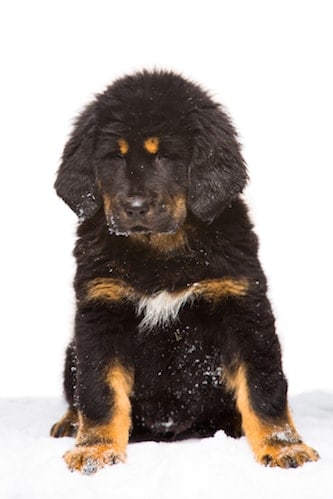
To complicate the issue still more, the parents may be second-generation mixes. For example, if a purebred Tibetan Mastiff and a purebred German Shepherd Dog (GSD) are crossed, the puppies will be 50% TM and 50% GSD.
But breeders often breed first-generation dogs back to purebreds, creating puppies that are 75% one parent and 25% the other.
All of this means that there will be a lot of individual difference in a crossbreed, making temperament harder to predict.
As we discuss the Tibetan Mastiff mix breeds below, we mention similarities of the two breeds being crossed. We then talk about temperament traits that are different in the two breeds.
These are the traits that are likely to be most variable in a mix. They can influence the temperament of the other breed a lot, a little, or so little it’s not noticeable.
They can offer some guidance as to possibilities but only in a broad sense. Knowing the possible combinations of two breeds’ temperaments can also help you to rule out traits you know you don’t want (like aggression).
But predicting temperament in mixed breeds is a crapshoot. You will still need to evaluate a pup’s individual temperament.
For more information on evaluating mixed-breed temperament, please see our Guide to a Successful Dog Relationship.
Takeaways
In the world of designer dogs, the massive Tibetan Mastiff makes for some fascinating Tibetan Mastiff mix breeds. However, if you’re considering finding one of these “designer dogs,” you’ll want to choose carefully.
Because of the TM’s sheer size and aggressive tendencies, a cross with another aggressive breed can be dangerous, particularly if that dog is also a giant breed. All Tibetan Mastiffs need early socialization and firm training. When they are mixed with other giant breeds, with or without aggression, meeting those needs will be even more critical.

Calvin is the co-founder and one of the main contributors to dogtemperament.com. He has been an avid dog lover all his life. He enjoys researching and sharing great ideas on how you can avoid common pitfalls of dog ownership and build the most loving and enjoyable relationship with your dog.
